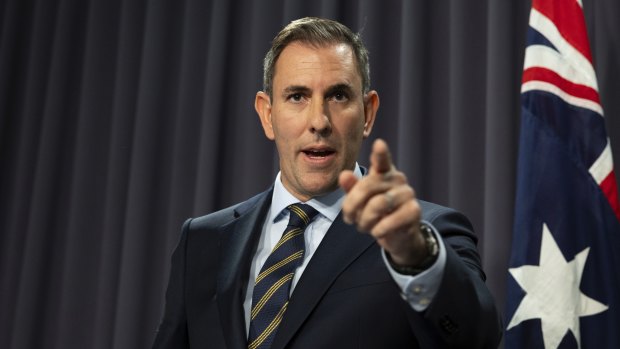This was published 6 months ago
Opinion
If Chalmers gets the budget wrong, interest rate rises may kill his government
Shane Wright
Senior economics correspondentFederal budgets can make or break a government – and the treasurers who deliver them.
Jim Chalmers, about to deliver his third budget in just 19 months, is now facing a moment of economic and political truth that could very well determine the fate of Anthony Albanese’s Labor government.

Jim Chalmers, delivering his third federal budget, faces his toughest challenge yet.Credit: Alex Ellinghausen
A combination of issues – some long simmering, some from out of the blue, some self-made – could make or break Chalmers’ treasurership and the plans he has been mapping out since assuming the job in 2022.
The biggest problems are economic. Inflation, at 3.6 per cent, is too high despite falling sharply over the past 15 months. Economic growth is, to be generous, anaemic. If not for population growth, the economy would have been in recession since the middle of last year.
We still have a strong jobs market (albeit starting to slow), poor productivity growth and a long-awaited lift in wages – but living standards are falling.
Some of these interconnected issues are long-term problems. The slowdown in productivity, for instance, has been worldwide and dates from around the global financial crisis of 2008.
Others are tied to the response by governments and central banks to the pandemic when they spent too much to keep the economy from collapsing. This was exacerbated by the supply problems caused by COVID restrictions and the war in Ukraine.
Ordinarily, inflation would force the government to cut spending, beef-up the surplus and tell consumers to put away the credit card.
But Chalmers has another problem. The economy feels like it’s in recession. Retail spending, for instance, is falling in per capita terms because the cost of living – including interest rates and tax – is going up.
Just last week, the Bureau of Statistics revealed that while the official inflation rate is at a 2½ year low, for families with a mortgage the real inflation rate is around 6.6 per cent. That’s because the interest rates on their loans continue to climb.
Even Reserve Bank governor Michele Bullock noted this week the sticker shock she suffered when fuelling up her vehicle at the weekend. Global oil prices, pressed up by the ongoing tensions in the Middle East, are beyond the control of the central bank and the federal government. But treasurers tend to cop the blame for the pain anyway.
On top of that are the long-term problems that previous governments put on the backburner (or tried to will away).
The most obvious is the decarbonisation of the Australian economy. The best and cheapest way to encourage businesses and communities to reduce their greenhouse footprints is to have a carbon price. But voters, urged on by the populist impulses of Tony Abbott, killed this at the 2013 election.
Ever since, governments have used taxpayers’ money to reduce our emissions. The delay caused by the Abbott government’s decision to throw economic and environmental reality to the wind can be measured by the billions being sunk into the transmission network, electrification of the manufacturing sector and power storage.
This government has its own policy weakness. Albanese’s declaration that Australia must be a country that “makes stuff” seems a justification for the government to play roulette with taxpayers’ money.
Unless China is about to stop exporting solar panels to the world, there doesn’t appear to be a pressing need to throw $1 billion at a domestic solar panel manufacturing industry. And when one of the government’s investments fail, as they inevitably will, it will be taxpayers wearing the cost.
Another problem is around the higher education system, which has been creaking for years. The $3 billion promise around HELP repayment levels is just the start of a desperately needed policy overhaul.
The population growth that has kept the economy afloat is putting pressure on infrastructure, be it from simply housing people to the roads or rail systems required to move those people around their communities or to jobs.
But that requires spending, which brings Chalmers back to the economic problems around inflation and growth.
If Chalmers gets much wrong (and, to be fair, all budgets contain decisions that simply don’t work), he could be dealing with an interest rate rise or two over coming months that would likely be political nails in the government’s coffin.
Just as easily, the economy could slow, which would push people out of work that would exacerbate the cost of living pressures facing many Australians. That would force the Reserve Bank into cutting interest rates – but the political benefit from that would be offset by the tens of thousands of people put out of work. That would be political poison.
The government has drifted politically since last year’s Voice referendum. The economic pain is translating into a fall-off in overall support for Labor, but the budget is seen as a way to reset the debate ahead of the next election, still expected to be in May next year.
Chalmers’ position as treasurer is assured. The budget is not only the biggest moment of the year for him to shine, but it’s also vital for the government in re-asserting its message to voters that it knows what it is doing.
If Chalmers fails to arrest the slide in government polling, the man considered most likely to succeed Albanese as the country’s next Labor prime minister would have a large black mark on his copybook.
Using the budget to navigate the economy through a particularly tough patch is Chalmers’ primary mission. But the future of the government, and his own long-term aspirations, will also be on the line come the night of May 14.
Shane Wright is a regular columnist and senior economics correspondent.
The Opinion newsletter is a weekly wrap of views that will challenge, champion and inform your own. Sign up here.